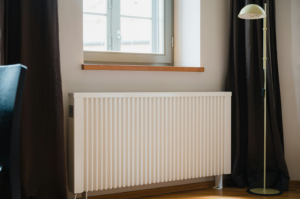Most of us spend a lot of time indoors, and therefore, the quality of the air we breathe at home matters. Poor indoor air quality leads to a host of health problems, including allergies, asthma, and other respiratory issues. Fortunately, a variety of air quality solutions are available to help homeowners improve the air in their living spaces.
In this blog, we’ll explore the discomfort of poor air quality and offer practical solutions to ensure that you and your family can breathe easy at home.
The Importance of Good Indoor Air Quality
Indoor air quality refers to the condition of the air within and around buildings and structures, particularly as it relates to the health and comfort of the occupants. Many homeowners may not realize that indoor air can be more polluted than outdoor air due to a combination of factors such as poor ventilation, household chemicals, dust, mold, and allergens.
Health Risks of Poor Indoor Air Quality
Exposure to poor indoor air quality can lead to immediate and long-term health effects. Common symptoms include headaches, dizziness, fatigue, and irritation of the eyes, nose, and throat.
For individuals with pre-existing respiratory conditions, poor air quality can exacerbate their symptoms, leading to more frequent asthma attacks, respiratory infections, and even chronic respiratory diseases.
Long-term exposure to indoor air pollutants has also been linked to serious health conditions such as heart disease and cancer. Given these risks, it’s essential to take proactive steps to improve the air quality in your home.
Common Indoor Air Pollutants
Before exploring air quality solutions, it’s important to understand the common pollutants that can compromise indoor air quality. Identifying these pollutants is the first step in creating a healthier home environment.
- Dust and Allergens
Dust mites, pet dander, pollen, and other allergens are common indoor pollutants that can trigger allergic reactions and asthma attacks. These microscopic particles can easily become airborne and circulate throughout your home, leading to respiratory issues and discomfort.
- Mold and Mildew
Mold and mildew thrive in damp, humid environments and can release spores into the air that are harmful when inhaled. Prolonged exposure to mold can cause respiratory problems, allergic reactions, and, in severe cases, long-term lung damage.
- Volatile Organic Compounds (VOCs)
VOCs are chemicals found in many household products, such as paints, cleaning supplies, and air fresheners. These compounds can off-gas into the air, leading to respiratory irritation, headaches, and even long-term health effects like cancer
- Carbon Monoxide (CO)
Carbon monoxide is a colorless, odorless gas produced by burning fossil fuels. Inadequate ventilation or malfunctioning appliances such as furnaces and stoves can lead to the buildup of CO indoors, posing a serious risk of carbon monoxide poisoning.
- Radon
Radon is a naturally occurring radioactive gas that can seep into homes through cracks in the foundation. It’s the second leading cause of lung cancer, making it crucial to monitor and mitigate radon levels in your home.
Air Quality Solutions for Your Home
1. Air Purifiers
Air purifiers are one of the most popular and effective solutions for improving indoor air quality. These devices work by filtering out pollutants such as dust, allergens, and VOCs from the air. High-efficiency particulate air filters effectively trap minuscule airborne particles, such as dust, pollen, and pet dander, which measure as small as 0.3 microns.
Some advanced air purifiers also feature activated carbon filters, which can absorb odors and VOCs, further improving the air quality in your home. By placing air purifiers in key areas such as bedrooms and living rooms, you can significantly reduce the concentration of airborne pollutants.
2. HVAC System Maintenance
Indoor air quality relies heavily on the performance of your HVAC system; therefore, regular maintenance of your HVAC system is essential to ensure that it operates efficiently and effectively.
One common maintenance task is regularly changing your HVAC filters. These filters trap dust, allergens, and other pollutants, preventing them from circulating throughout your home. It’s recommended to replace or clean your HVAC filters every one to three months, depending on the type of filter and usage.
In addition to filter replacement, consider having your ductwork professionally cleaned by our HVAC service experts to remove dust, debris, and mold that may have accumulated over time. Proper ventilation is also key to maintaining good air quality, so ensure that your HVAC system is providing adequate ventilation to all areas of your home.
3. Ventilation Solutions
Proper ventilation is essential for reducing the concentration of indoor air pollutants. Without adequate ventilation, pollutants can build up to harmful levels, leading to poor indoor air quality. There are several air quality solutions that focus on improving ventilation in your home:
- Exhaust Fans: Installing exhaust fans in areas prone to moisture, such as bathrooms and kitchens, can help remove excess humidity and reduce the risk of mold and mildew growth.
- Whole-House Ventilation Systems: A whole-house ventilation system can continuously exchange indoor air with fresh outdoor air, helping to dilute and remove pollutants. These systems are particularly effective in homes with tight insulation, where natural ventilation may be limited.
- Windows and Doors: Whenever possible, open windows and doors to allow fresh air to circulate throughout your home. This simple practice can help improve air quality by reducing the concentration of indoor pollutants.

4. Dehumidifiers
Controlling humidity levels is crucial for preventing mold and mildew growth. Dehumidifiers are effective air quality solutions that remove excess moisture from the air, helping to maintain a healthy humidity level in your home.
Ideally, indoor humidity levels should be kept between 30% and 50%. High humidity levels create a breeding ground for mold and dust mites, while low humidity can lead to dry skin, irritated respiratory passages, and increased static electricity.
By using a dehumidifier, you can maintain optimal humidity levels, creating a more comfortable and healthier living environment.
5. Houseplants
Houseplants not only add beauty to your home but also help improve indoor air quality. Certain plants are known for their ability to absorb harmful pollutants and release oxygen, making them natural air purifiers.
Some of the best houseplants for improving air quality include:
- Spider Plant: Effective at removing formaldehyde and xylene from the air.
- Snake Plant: Known for filtering out benzene, formaldehyde, and other toxins.
- Aloe Vera: Helps remove formaldehyde and benzene while also providing soothing properties for skin irritations.
While houseplants alone won’t solve all indoor air quality issues, they can be a valuable addition to other air quality solutions.
6. Radon Mitigation
Given the serious health risks associated with radon exposure, it’s important to test your home for radon and take steps to mitigate it if necessary. Radon test kits are readily available and can help you determine if your home has elevated radon levels.
If radon levels are high, consider hiring a professional to install a radon mitigation system. These systems typically involve venting radon gas from beneath the foundation to the outside, preventing it from entering your home.
7. Carbon Monoxide Detectors
Installing carbon monoxide detectors is a critical step in ensuring your home’s air quality and safety. These devices monitor CO levels in your home and sound an alarm if dangerous levels are detected.
Place carbon monoxide detectors near sleeping areas and on every level of your home. Regularly test the detectors to ensure they are functioning properly and replace batteries as needed. In addition to detectors, make sure your home’s appliances, such as furnaces and stoves, are properly maintained to prevent CO buildup.
Maintaining good indoor air quality is essential for your health and comfort. By implementing these air quality solutions in your home, you can significantly reduce the concentration of pollutants and create a safer, healthier living environment for you and your family.

From air purifiers and HVAC maintenance to ventilation solutions and houseplants, there are numerous ways to improve your home’s air quality. At Grays LLC, we’re committed to helping homeowners breathe easy by providing expert advice and HVAC services tailored to your specific needs. Don’t wait until poor air quality affects your health—take action today and enjoy the benefits of clean, fresh air in your home.
